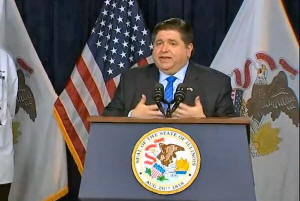Pritzker: Broader reopening to begin next week
 Send a link to a friend
Send a link to a friend
[May 07, 2021]
By PETER HANCOCK
Capitol News Illinois
phancock@capitolnewsillinois.com
 SPRINGFIELD – Gov. JB Pritzker said
Thursday that Illinois will enter the “bridge” phase to full reopening
on Friday, May 14. And barring any reversal of current trends, Phase 5,
or full reopening, will begin on June 11. SPRINGFIELD – Gov. JB Pritzker said
Thursday that Illinois will enter the “bridge” phase to full reopening
on Friday, May 14. And barring any reversal of current trends, Phase 5,
or full reopening, will begin on June 11.
He also announced that residents can now obtain COVID-19 vaccines from
their physicians’ offices, rather than just designated vaccine sites, as
public health officials continue to confront hesitancy within many
communities to accept the vaccines.
Thursday’s announcement came as the state reached a new benchmark of
having 55 percent of adults age 16 and over, and 80 percent of people
age 65 and over, having received at least one dose of vaccine, according
to the Illinois Department of Public Health. Meanwhile, the daily number
of new cases, hospitalization rates and intensive care unit usage have
all been falling or leveling off.

“This good news comes with a caveat,” Pritzker said. “We have all seen
throughout this pandemic that this virus and its variants have proven to
be unpredictable. Metrics that look strong today are far from a
guarantee of how things will look a week, two weeks, a month from now.
We saw that last August, and again last March.”
Under the bridge phase – a transition phase between the current Phase 4
mitigations and the virtually complete reopening of Phase 5 – certain
capacity limits will be eased at various kinds of events. Restaurants,
for example, will be allowed to increase from 25 to 30 percent of
capacity, as long as people maintain six feet of distance from one
another, while offices, personal care facilities and retail service
counters can increase from 50 to 60 percent of capacity.
When the state reaches Phase 5, Pritzker said, virtually all mitigation
restrictions will be lifted, although the state will still follow
guidelines from the U.S. Centers for Disease Control and Prevention
regarding wearing masks in large, crowded situations and maintaining
safe social distancing.
Although Illinois has succeeded in getting a large percentage of its
adult population vaccinated, IDPH reports that the daily rate of
vaccinations has been declining as large segments of the population have
been reluctant to receive their shots.
As of Thursday, the seven-day rolling average of daily doses
administered stood at 70,063, down from a peak of nearly 133,000 per day
in mid-April. But with the supply of vaccines now large enough to
provide vaccines to anyone who wants one, Pritzker said he hoped that
making them available through physicians’ offices will make it more
convenient for more people.
“This is about making it as easy as possible for those who have not yet
gotten vaccinated to protect themselves from COVID-19,” he said.
Still, there remain pockets of society that remain hesitant, whether
that be for cultural, political or religious reasons, and the Pritzker
administration is continuing its public relations campaign to reach out
to those communities.
[to top of second column]
|

Gov. JB Pritzker speaks at a news conference in
Chicago Thursday, announcing that the state will move to the
"bridge" phase of further reopening next week. (Credit:
Blueroomstream.com)

According to IDPH data, Sangamon County, which
includes Springfield, has the highest rate of vaccination with
nearly 39 percent of its population fully vaccinated. But in
Alexander County, which includes Cairo at the southern tip of
Illinois, only 11 percent are fully vaccinated.
Joining Pritzker at Thursday’s news conference was Dr. Rodney
Alford, an African American pediatric and internal medicine
specialist at Iroquois Memorial Hospital and a trustee of the
Illinois State Medical Society.
“I myself belong to that community that has vaccine hesitancy,” he
said. “I belong to the Black and brown community. I belong to the
conservative Christian community. I belong to the urban community. I
now live in a rural community. But I am not hesitant to live without
fear. I am truly free.”
Although the rate of spread of the virus has been declining, IDPH
continues to report a steady stream of new cases each day. On
Thursday, the agency reported 1,778 new confirmed and probable cases
over the previous 24 hours and 40 additional deaths.
The preliminary seven-day statewide average case positivity rate for
cases as a percent of tests performed stood at 3.0 percent, the
lowest it has been since March 27
As of late Wednesday night, 2,055 people in Illinois were reported
hospitalized with the disease, including 483 patients in intensive
care units and 243 on ventilators.

Jobless claims drop
Illinois also continued to see a drop in the number of new
unemployment claims over the past week, although the total number of
people unemployed remained at historically high levels.
The Illinois Department of Employment Security reported 15,134 new
jobless claims were filed during the week that ended Saturday, May
1. That was down from 17,141 from the prior week, but it was
considerably less than the 74,476 workers who filed initial claims
during the same week a year ago.
Meanwhile, U.S. Department of Labor reported a total of just under
250,000 Illinois workers were receiving continuing regular
unemployment benefits at the end of April.
Capitol News Illinois is a nonprofit, nonpartisan
news service covering state government and distributed to more than
400 newspapers statewide. It is funded primarily by the Illinois
Press Foundation and the Robert R. McCormick Foundation. |